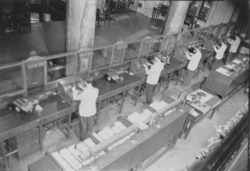Bank teller
Topic: Finance
 From HandWiki - Reading time: 2 min
From HandWiki - Reading time: 2 min
A bank teller (often abbreviated to simply teller) is an employee of a bank whose responsibilities include the handling of customer cash and negotiable instruments. In some places, this employee is known as a cashier or customer representative.[1] Tellers also deal with routine customer service at a branch.
Responsibilities and duties of the bank teller
Being front-line staff they are most likely to detect and stop fraudulent transactions in order to prevent losses at a bank (counterfeit currency and cheques, identity theft, confidence tricks, etc.). The position also requires tellers to be friendly and interact with the customers, providing them with information about customers' accounts and bank services. Tellers typically work from a station, usually located on a teller line. Most stations have a teller system, which includes cash drawers, receipt validator/printers, proof work sorters, and paperwork used for completing bank transactions. These transactions include:
- Check cashing, depositing, transfers, wire transfers
- Savings deposits, withdrawals
- Issuing negotiable items (cashier's checks, traveler's cheques, money orders, federal draft issuances, etc.)
- Payment collecting
- Promotion of the financial institution's products (loans, mortgages, etc.)
- Facilitating applications for retail credit products (short-term financing, credit cards, etc.)
- Business referrals (trust, insurance, lending, etc.)
- Cash advances
- Savings bond redemption
- Resolving customer issues
- Balancing the vault, cash drawers, ATMs, and TAUs
- Batching and Processing Proof Work (on-us/not-on-us checks, payment coupons, counter slips, etc.)
- May include ordering products for the customer (cheques, deposit slips, etc.)
Prevalence and history
In the United States, tellers held approximately 608,000 jobs in 2006. Of these, approximately 25% were classified as part-time. Median annual earnings as of May 2006 were $22,140.[2]
The number of tellers in the United States increased from approximately 300,000 in 1970 to approximately 600,000 in 2010. A contributing factor may have been the introduction of automated teller machines. ATMs allow a branch to operate with fewer tellers, making it more economical for banks to open more branches, necessitating more tellers to staff those additional branches. Further automation and online banking, however, may reverse this increase resulting in a trend toward fewer bank teller positions. [3]
Public figures who were former bank tellers
Many well-known personalities have worked as bank tellers including:
- Whoopi Goldberg[4]
- Ray Romano[5]
- Scott Adams
- William Singe
- Wolfgang Stark
- John Legend
- Kim Dong-yeon
See also
- Automated teller machine (ATM)
- Front office (finance)
- Cashier
References
- ↑ "Scotiabank Jobs". http://jobs.scotiabank.com/ca/alberta/retail-banking/jobid8239992-customer-representative-(part-time)-jobs.
- ↑ "Tellers". Occupational Outlook Handbook. U.S. Bureau of Labor Statistics. May 2006. http://www.bls.gov/oco/ocos126.htm.
- ↑ Tess Townsend (May 8, 2017). "Eric Schmidt said ATMs led to more jobs for bank tellers. It’s not that simple.". Recode. https://www.recode.net/2017/5/8/15584268/eric-schmidt-alphabet-automation-atm-bank-teller.
- ↑ "10 of the Most Famous Financial Advisors". https://www.investopedia.com/articles/fa-profession/092516/10-most-famous-financial-advisors-brka.asp.
- ↑ "9 Boring Jobs Celebrities Had Before They Were Famous". https://www.jobs.net/Article/CB-152-Talent-Network-Hospitality-9-Boring-Jobs-Celebrities-Had-Before-They-Were-Famous/.
 |
 KSF
KSF

